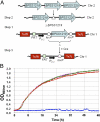Antimicrobial resistance to ceftazidime involving loss of penicillin-binding protein 3 in Burkholderia pseudomallei
- PMID: 21969582
- PMCID: PMC3193241
- DOI: 10.1073/pnas.1111020108
Antimicrobial resistance to ceftazidime involving loss of penicillin-binding protein 3 in Burkholderia pseudomallei
Abstract
Known mechanisms of resistance to β-lactam antibiotics include β-lactamase expression, altered drug target, decreased bacterial permeability, and increased drug efflux. Here, we describe a unique mechanism of β-lactam resistance in the biothreat organism Burkholderia pseudomallei (the cause of melioidosis), associated with treatment failure during prolonged ceftazidime therapy of natural infection. Detailed comparisons of the initial ceftazidime-susceptible infecting isolate and subsequent ceftazidime-resistant variants from six patients led us to identify a common, large-scale genomic loss involving a minimum of 49 genes in all six resistant strains. Mutational analysis of wild-type B. pseudomallei demonstrated that ceftazidime resistance was due to deletion of a gene encoding a penicillin-binding protein 3 (BPSS1219) present within the region of genomic loss. The clinical ceftazidime-resistant variants failed to grow using commonly used laboratory culture media, including commercial blood cultures, rendering the variants almost undetectable in the diagnostic laboratory. Melioidosis is notoriously difficult to cure and clinical treatment failure is common in patients treated with ceftazidime, the drug of first choice across most of Southeast Asia where the majority of cases are reported. The mechanism described here represents an explanation for ceftazidime treatment failure, and may be a frequent but undetected resistance event.
Conflict of interest statement
The authors declare no conflict of interest.
Figures



References
-
- Woodford N, Livermore DM. Infections caused by Gram-positive bacteria: A review of the global challenge. J Infect. 2009;59(Suppl 1):S4–S16. - PubMed
-
- Livermore DM. Mechanisms of resistance to cephalosporin antibiotics. Drugs. 1987;34(Suppl 2):64–88. - PubMed
-
- Chierakul W, et al. Two randomized controlled trials of ceftazidime alone versus ceftazidime in combination with trimethoprim-sulfamethoxazole for the treatment of severe melioidosis. Clin Infect Dis. 2005;41:1105–1113. - PubMed
Publication types
MeSH terms
Substances
Associated data
- Actions
Grants and funding
LinkOut - more resources
Full Text Sources
Other Literature Sources
Medical
Molecular Biology Databases

